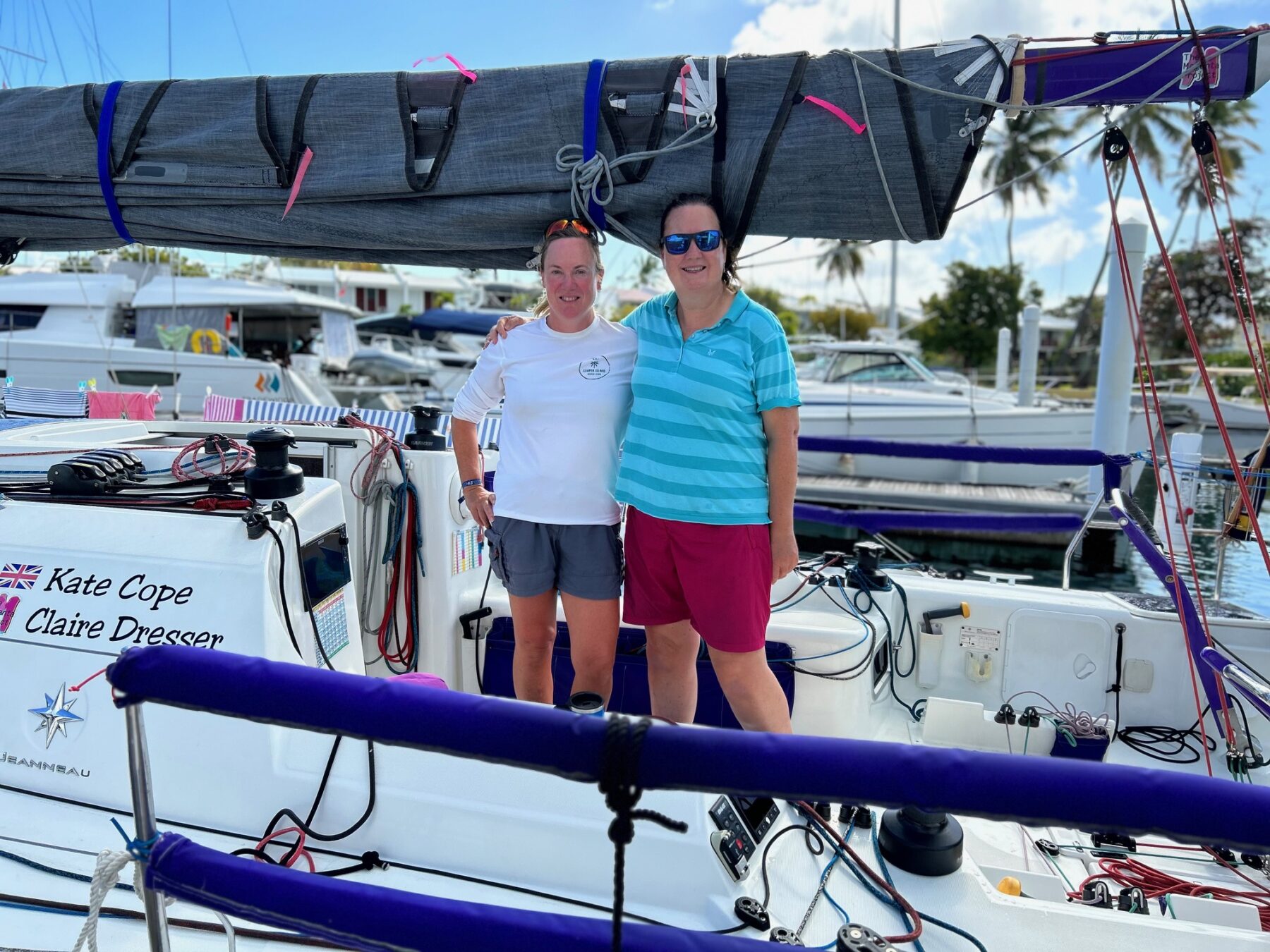Kate Cope checked off a bucket list goal in January: racing double handed across the Atlantic in the RORC Transatlantic Race. She sailed on Purple Mist, her Sunfast 3200R2, with Claire Dresser, 54, from Hamble, UK. The 56-year-old from Ascot, UK, bought her boat new in December 2018 and made significant modifications for short-handed sailing, taking the helm position and all controls aft in the transom area.
“There are five jobs to do in that area which you wouldn’t have on a fully crewed boat,” she explained. “I love the boat and it really is the perfect boat for me.”

Cope and Dresser met last year and quickly knew that they would be a good team together to take on crossing the Atlantic and decided to make the best of their time in the Caribbean with a mixture of racing and cruising for three-four months, until Claire heads back to the UK in April for work. This week they’re racing the BVI Spring Regatta, and while double-handed distance racing is truly Cope’s “thing”, it’s not every day she gets to have her own boat in the BVI so she’s making the most of every moment, distance and buoy racing.
For someone as nuts about sailing as Cope is, she got a somewhat late introduction to the sport in her 30s. Her first experience on a sailboat was on a Sunsail holiday in the Greek Islands and she was instantly smitten. On her return home she did a day skipper qualification with Hamble School of Yachting, and a lot of informal training with the Royal County of Berkshire Yacht Club. Not long after she and her dad, also not a sailor, bought their first boat together – a Jeanneau Sun Odyssey 36I – and together became better sailors.
“I did my yacht master in that boat, the first Purple Mist,” Cope noted. “We initially did a lot of cruising down the south coast of England, over to France, all along the Brittany and north coast of France. We started off doing short day trips, like over to the Isle of Wight, in good weather, then went a little bit further each time we went out, it was a good way to learn.”
Learning to race happened similarly for Cope.
“You don’t really learn to race in one go, it evolves,” she said. “We did the Rolex Fastnet, which was also on the bucket list on my old cruising boat with six yacht master qualified sailors, but no-one was a racer. We went as fast as we could but looking back it wasn’t very fast!”
Since then, Cope has made big strides in the double-handed sailing community in the UK and now runs a double-handed offshore series. She’s also built her skills through the Magenta Project, a global women’s sail mentoring program, as a mentee and was mentored by Paralympic sailor Hannah Stodel. She reached out to others for coaching by simply asking and has had all kinds of people help her out.
“I’ve never paid for any coaching but I’ve had all sorts of great people on the boat,” she said. “Ex Figaro sailor, Henry Bomby who sails on RAN, helped me out – I traded him sail covers for coaching.”
Crossing the Atlantic with someone that she did not know well could have gone sideways pretty quickly, Cope acknowledged. “We got on really well on the Atlantic race with our biggest challenge happening early in the race. We had been up with the lead boats for the first few days when on day three, Claire was on deck alone, flying the kite under a full main. A squall hit, Claire encountered an issue on reefing the main and the spinnaker wrapped around the forestay, so we had two problems at once.”
It was nighttime, there was a squall, it was thundering with rain, and the whole rig was shaking, Cope recalled, and there were reasons why they couldn’t jibe back to untangle the spinnaker.
“There was no blame and it was a good moment in a way as we really worked together as a team to work through priorities: lashing the boom to the deck, lashing the mainsail to the deck, then figuring out how to unwrap the kite.”
Purple Mist finished the RORC Transatlantic Race in Grenada then went cruising in the southern Caribbean – Grenada, Union Island, Tobago Keys, and Bequia. The boat was set up from the outset for racing, not cruising, so the only anchor on board was the minimum required by the Atlantic race, and without a dinghy, they have chosen cruising grounds where they could find water taxis. After cruising, Cope and Dresser raced the RORC Caribbean 600 from Antigua, and then the Heineken Regatta in St Marten where Dresser’s daughter Emily and a friend raced with them.
“We were the first two women to do the RORC 600 double-handed – it took us five days which was almost tougher than the Transat as we were in full-on race mode nonstop for those five days,” Cope reflected. “I did enjoy it and the weather was thankfully quite kind to us.”
Cope’s advice for other women curious about double-handing and ocean racing: “Just walking the docks and talking sailing, chatting to others about sailing is where you learn – “Why did you go that way?”” Why did you have that sail up?” “How did you trim that sail?” You just keep asking!” – Michelle Slade

